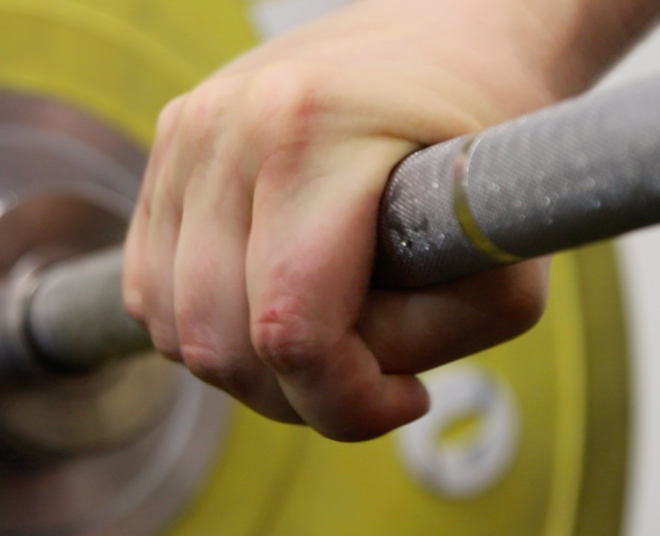The hook grip and why we use it
One of the first things you should learn when weightlifting is the Hook Grip. Synonymous with one of the biggest brands now in the world of lifting, this grip variation really does serve a purpose other than to make your thumb hurt.
What is the hook grip? (and closed grip)
The hook grip is novel to most lifters when starting out and with good reason. Everything else we do in life we usually use what’s simply called a ‘closed grip’. If you make a fist (a proper one with the thumb on the outside of the fingers) that’s a standard closed grip. It seems natural that one would assume this is the strongest option as it is what we commonly use and default to.
In contrast the hook grip requires the thumb be inside the fingers and as far round the implement (in our case the barbell) as possible and for good reason(s). The thumb has some pretty strong muscles of its own and we can use them directly once the thumb is tucked in.
What does the hook grip do that the regular closed grip does not?
When we lift a round object like a barbell gravity acts continually on the weight, like it’s trying to pry our hands open and force us to drop the bar / miss the lift. Gravity, although a bit of a dick, isn’t the worst bit. Good technique in the classic lifts will utilise a contact of the bar at the hip or thigh to give extra upwards drive to the barbell. This contact creates friction and literally can spin the bar in our hands - or at least it would if we use a closed grip. The hook grip usually prevents this by using the thumb and fingers to counteract the rotation of the bar although you can occasionally see the thumb slip out and the bar go flying away from the lifter. For the same reason, Powerlifters will use a ‘mixed grip’ where one hand is over and the other under - cancelling each other out to prevent the bar rotating out of their hands on heavy deadlifts. Patt et al. (2020) showed that some people find the mixed grip the easiest but in weightlifting we have to use a double overhand position in either a closed or hook grip. (If you want to see someone clean with a mixed grip just google ‘continental cleans’).
Another benefit may also be that using a hook grip requires less conscious tension in the forearms. We don’t need to grip as hard as the hand is naturally more secure. This means we can direct attention and effort elsewhere.
In studies comparing the closed grip and hook grip subjects report ‘greater grip security’. If you’re more confident about having the bar under control it stands to reason you will perform better in the lifts.
Research showing the hook grip works better…
Although it’s a bit alien and can be painful at first, the hook grip is shown to increase power output and lift performance in the power clean (Oranchuk, 2019). Although there is also some research suggesting the differences are not significant in power snatches (Kennedy, 2020) I would theorise that is because the exercise variation studied required lighter loads where maybe the grip makes the least difference. In addition, that study also included lifting straps as a test variable which out-performed the two grip options but are allowed only in training not competition so cannot be relied on all the time.
In the 2019 study on power cleans, test subjects performed better in all intensities of the power clean using the hook grip (peak force, peak velocity, peak power). I’d like to see a study on the full snatch and full clean but they’re a bit more technically demanding and it’s harder to find subjects I imagine.
The hook grip makes enough of a difference that people try to cheat by using a longer thumb…
In weightlifting it is against the rules to have thumb tape beyond the end of your thumb as it’ wraps further around the bar giving you even more surface area to grip. I’ve even heard of people growing their thumb nails to gain an advantage.
Thumb tape does help keep the thumb skin protected but is a very personal preference as it also takes some getting used to. I’d suggest getting used to the hook grip first before deciding if you want to use tape as well. Personally I find tape can be a distraction as it can slip or prevent your thumb bending as comfortably. The bar you train on and how sharp it’s knurling is could be the decider.
If you’re new to lifting and yet to make the hook grip your go-to position, I can’t recommend it strongly enough. It will take a few sessions to get used to but before long you won’t even think about it. Chalk up and tough it out.
References:
Kennedy, C. (2020). The Influence of the Closed Grip, Hook Grip, and Lifting Straps on Kinetic, Kinematic, and Qualitative Performance Variables of the Power Snatch (Doctoral dissertation, Auckland University of Technology).
Oranchuk, D. J., Drinkwater, E. J., Lindsay, R. S., Helms, E. R., Harbour, E. T., & Storey, A. G. (2019). Improvement of kinetic, kinematic, and qualitative performance variables of the power clean with the hook grip. International journal of sports physiology and performance, 14(3), 378-384.
Pratt, J., Hoffman, A., Grainger, A., & Ditroilo, M. (2020). Forearm electromyographic activity during the deadlift exercise is affected by grip type and sex. Journal of Electromyography and Kinesiology, 53, 102428.

